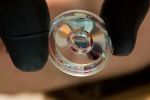Research Unravels Genomic Secret
Published online in Molecular Cell on February 12, the new research addresses a mystery that has shrouded the sequencing of the human genome - what is the purpose of 98 per cent of our DNA?
In collaboration with two teams of researchers in the United States, WAIMR's Dr Archa Fox has pinpointed a unique role of non-coding RNA - an element included in the majority of the genome with a largely unidentified purpose.
"We have discovered that the role of 'Neat1', a non-coding RNA, is to be the structural foundation for paraspeckles, an important storehouse within the nucleus of every cell," she said.
"When the human genome was mapped, it was a big surprise that only two percent of it was made up of protein-coding genes - of which there are between 20,000 to 25,000 genes."
"However, that two percent alone can't explain our complexity as humans, so the question has remained - what is the function of the remaining 98 percent of our genomes if it's not to make protein?"
"In our research, we concentrated on the purpose of 'Neat1' - a type of non-coding RNA, and we found that its role is to create the structure for paraspeckles."
In 2002, Dr Fox was the first to discover paraspeckles which are found in the nucleus of a cell and function like warehouses, storing the building materials for important proteins, so that when the cell places an order, the materials are released, allowing proteins to be produced.
Paraspeckles provide a way for cells to more carefully control which proteins are created and therefore control cell development, and it's believed they save cells 25 minutes in processing each time they need a protein.
Unlike genes, non-coding RNA are molecules that do not help produce protein. Thanks to this new research, we now know that non-coding RNA, like proteins, can also act as a building block, to help build important parts of the cell.
Story from ScienceAlert.com.au
Popular Tags
SciTech
Regular Features

| regarding | user | just commented |
|---|---|---|
| Friday YouTube: Super Mario 64 Record Run | Ulyssus | One of the best games ever! |
| Oh, Mama Mia! | Ulyssus | I'll admit that I torrent |
| Cross Battle Adaptor Brings Xbox 360 Controller to PS3, With Rumble | Karl777 | Aside from the benefit of |
| Friday YouTube: Super Mario 64 Record Run | Karl777 | I was playing Mario Golf on |
| Blowing (Up) Hydrogen Bubbles | Highboy | People don't seem to realise |
Featured
SciTech
Science Confirms the Obvious 2008
The findings may be no-brainers (yes, you do get sick in winter), but these studies uncover hidden truths in conventional wisdomBuilding the Real Iron Man
While audiences flood theaters this month to see the comic-book-inspired Iron Man, a real-life mad genius toils in a secret mountain lab to make the mechanical superhuman more than just a fantasy with the XOS Exoskeleton
Popular on Popsci
Most Viewed
Most Commented
SciTech
- High Speed Rail Link to Make Canberra Sydney’s Second Airport
- Tilt Train Technology
- Are You Going to Eat That?
- Bigger Balls - PopSci Investigates Tennis
- Stay Healthy or Go Blind!
- Oh, Mama Mia!
- Enzyme Cleans Up Pesticide
- Armstrong Sends the Birds After His Stolen Bike
- Public Hospitals Help Risky Births
- Does Hollywood Really Need to Get the Science Right?
Most Emailed
SciTech
- Hunting The Elusive Fat Pill
- Ladies and gentlemen, the Reebok Pump is Back on the Scene! Well, Sort Of
- The Secret of Successful Kissing
- Oh, Mama Mia!
- The Unusual Suspects
- The Race for Bosons
- Research Unravels Genomic Secret
- Developing Healthcare Needs Rethink
- I Don't Know But I Been Told
- Enzyme Cleans Up Pesticide








